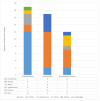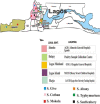Whole genome sequencing of Salmonella enterica serovars isolated from humans, animals, and the environment in Lagos, Nigeria
- PMID: 37312043
- PMCID: PMC10262361
- DOI: 10.1186/s12866-023-02901-1
Whole genome sequencing of Salmonella enterica serovars isolated from humans, animals, and the environment in Lagos, Nigeria
Abstract
Background: Salmonella infections remain an important public health issue worldwide. Some serovars of non-typhoidal Salmonella (NTS) have been associated with bloodstream infections and gastroenteritis, especially in children in Sub-Saharan Africa with circulating S. enterica serovars with drug resistance and virulence genes. This study identified and verified the clonal relationship of Nigerian NTS strains isolated from humans, animals, and the environment.
Methods: In total, 2,522 samples were collected from patients, animals (cattle and poultry), and environmental sources between December 2017 and May 2019. The samples were subjected to a standard microbiological investigation. All the isolates were identified using Microbact 24E, and MALDI-TOF MS. The isolates were serotyped using the Kauffmann-White scheme. Antibiotic susceptibility testing was conducted using the disc diffusion method and the Vitek 2 compact system. Virulence and antimicrobial resistance genes, sequence type, and cluster analysis were investigated using WGS data.
Results: Forty-eight (48) NTS isolates (1.9%) were obtained. The prevalence of NTS from clinical sources was 0.9%, while 4% was recorded for animal sources. The serovars identified were S. Cotham (n = 17), S. Give (n = 16), S. Mokola (n = 6), S. Abony (n = 4), S. Typhimurium (n = 4), and S. Senftenberg (n = 1). All 48 Salmonella isolates carried intrinsic and acquired resistant genes such as aac.6…Iaa, mdf(A), qnrB, qnrB19 genes and golT, golS, pcoA, and silP, mediated by plasmid Col440I_1, incFIB.B and incFII. Between 100 and 118 virulence gene markers distributed across several Salmonella pathogenicity islands (SPIs), clusters, prophages, and plasmid operons were found in each isolate. WGS revealed that strains of each Salmonella serovar could be assigned to a single 7-gene MLST cluster, and strains within the clusters were identical strains and closely related as defined by the 0 and 10 cgSNPs and likely shared a common ancestor. The dominant sequence types were S. Give ST516 and S. Cotham ST617.
Conclusion: We found identical Salmonella sequence types in human, animal, and environmental samples in the same locality, which demonstrates the great potential of the applied tools to trace back outbreak strains. Strategies to control and prevent the spread of NTS in the context of one's health are essential to prevent possible outbreaks.
Keywords: MLST; Nigeria; Resistant gene; Salmonella; Serotyping; Virulence gene; WGS.
© 2023. The Author(s).
Conflict of interest statement
The authors declare no competing interests.
Figures




Similar articles
-
Rare serovars of non-typhoidal Salmonella enterica isolated from humans, beef cattle and abattoir environments in Nigeria.PLoS One. 2024 Jan 22;19(1):e0296971. doi: 10.1371/journal.pone.0296971. eCollection 2024. PLoS One. 2024. PMID: 38252613 Free PMC article.
-
The rare Salmonella enterica serovar Isangi: genomic characterization of the antimicrobial resistance, virulence potential and epidemiology of Brazilian strains in comparison to global isolates.J Med Microbiol. 2023 Jul;72(7). doi: 10.1099/jmm.0.001736. J Med Microbiol. 2023. PMID: 37462464
-
Genome-Based Assessment of Antimicrobial Resistance and Virulence Potential of Isolates of Non-Pullorum/Gallinarum Salmonella Serovars Recovered from Dead Poultry in China.Microbiol Spectr. 2022 Aug 31;10(4):e0096522. doi: 10.1128/spectrum.00965-22. Epub 2022 Jun 21. Microbiol Spectr. 2022. PMID: 35727054 Free PMC article.
-
Host-pathogen interaction in invasive Salmonellosis.PLoS Pathog. 2012;8(10):e1002933. doi: 10.1371/journal.ppat.1002933. Epub 2012 Oct 4. PLoS Pathog. 2012. PMID: 23055923 Free PMC article. Review.
-
Prevalence and distribution of non-typhoidal Salmonella enterica serogroups and serovars isolated from normally sterile sites: A global systematic review.Epidemiol Infect. 2023 Oct 18;152:e4. doi: 10.1017/S0950268823001693. Epidemiol Infect. 2023. PMID: 37850326 Free PMC article.
Cited by
-
ESBL-Type and AmpC-Type Beta-Lactamases in Third Generation Cephalosporin-Resistant Enterobacterales Isolated from Animal Feces in Madagascar.Animals (Basel). 2024 Feb 27;14(5):741. doi: 10.3390/ani14050741. Animals (Basel). 2024. PMID: 38473126 Free PMC article.
-
Drug resistance and genotyping studies of Salmonella Enteritidis isolated from broiler chickens in Iran.Front Vet Sci. 2025 Feb 18;12:1542313. doi: 10.3389/fvets.2025.1542313. eCollection 2025. Front Vet Sci. 2025. PMID: 40041666 Free PMC article.
-
Genomic insights into multidrug - resistant Salmonella enterica isolates from pet dogs and cats.Sci Rep. 2025 Jul 1;15(1):22104. doi: 10.1038/s41598-025-06301-5. Sci Rep. 2025. PMID: 40596330 Free PMC article.
-
Characterization of nontyphoidal Salmonella strains from a tertiary hospital in China: serotype diversity, multidrug resistance, and genetic insights.Front Cell Infect Microbiol. 2024 Jan 9;13:1327092. doi: 10.3389/fcimb.2023.1327092. eCollection 2023. Front Cell Infect Microbiol. 2024. PMID: 38264733 Free PMC article.
-
A systematic review of antimicrobial resistance transmission inferences at the human-livestock interface in Africa.NPJ Antimicrob Resist. 2025 Jun 30;3(1):58. doi: 10.1038/s44259-025-00126-y. NPJ Antimicrob Resist. 2025. PMID: 40588479 Free PMC article.
References
-
- Rotimi V, Jamal W, Pal T, Sonnevend A, Dimitrov T, Albert MJ. Emergence of multidrug-resistant Salmonella spp. and isolates with reduced susceptibility to ciprofloxacin in Kuwait and the United Arab Emirates. Diagnostic microbiology and infectious disease 2008, 60(1):71–7. - PubMed
-
- Razzaque M, Bedair M, Abbas S, Al-Mutawa T. Economic impact of calf mortality on dairy farms in Kuwait. Pakistan Vet J. 2009;29(3):97–101.
-
- Parry CM, Thomas S, Aspinall EJ, Cooke RP, Rogerson SJ, Harries AD, Beeching NJ. A retrospective study of secondary bacteraemia in hospitalised adults with community acquired non-typhoidal Salmonella gastroenteritis. BMC Infect Dis. 2013;13(1):1–10. doi: 10.1186/1471-2334-13-107. - DOI - PMC - PubMed
Publication types
MeSH terms
LinkOut - more resources
Full Text Sources

